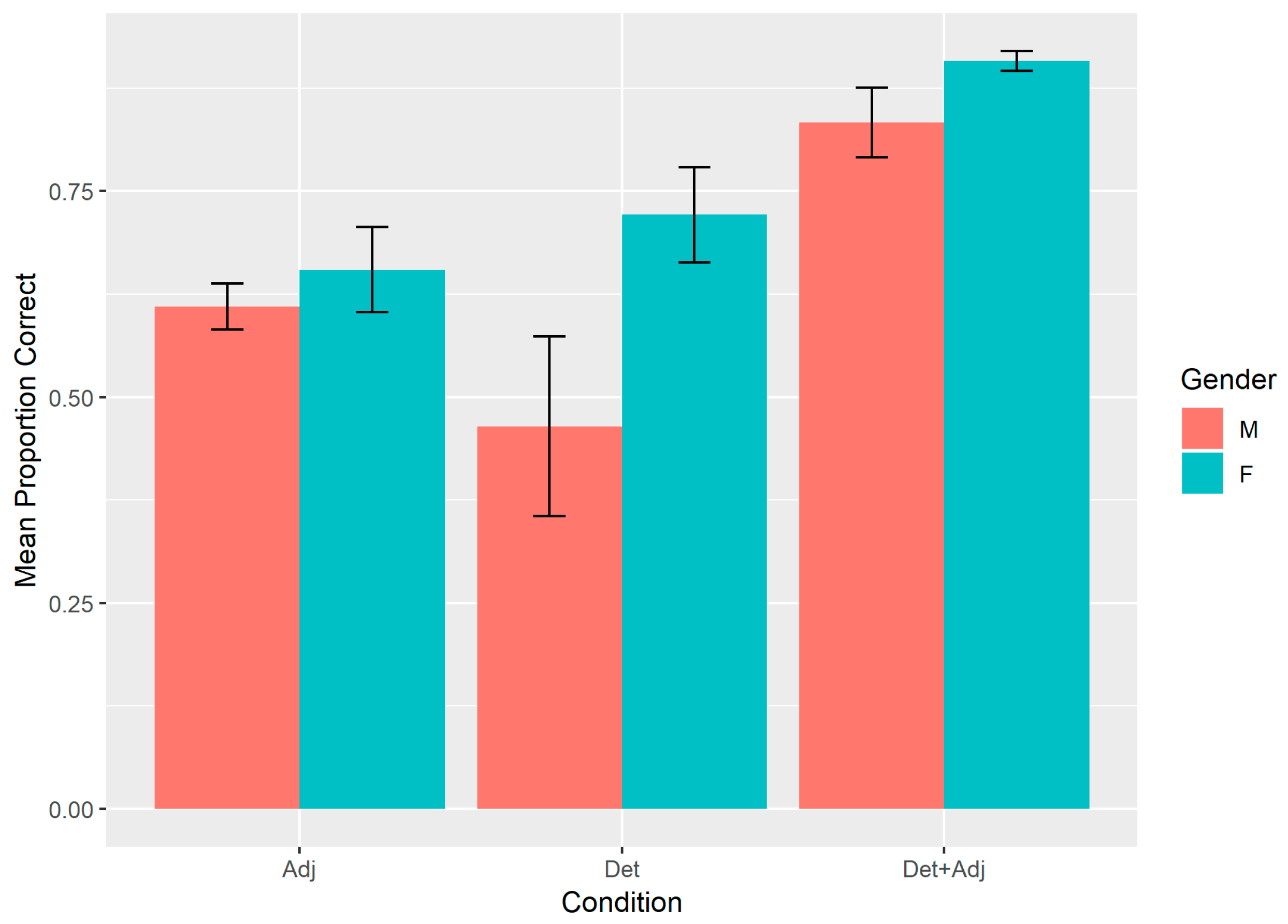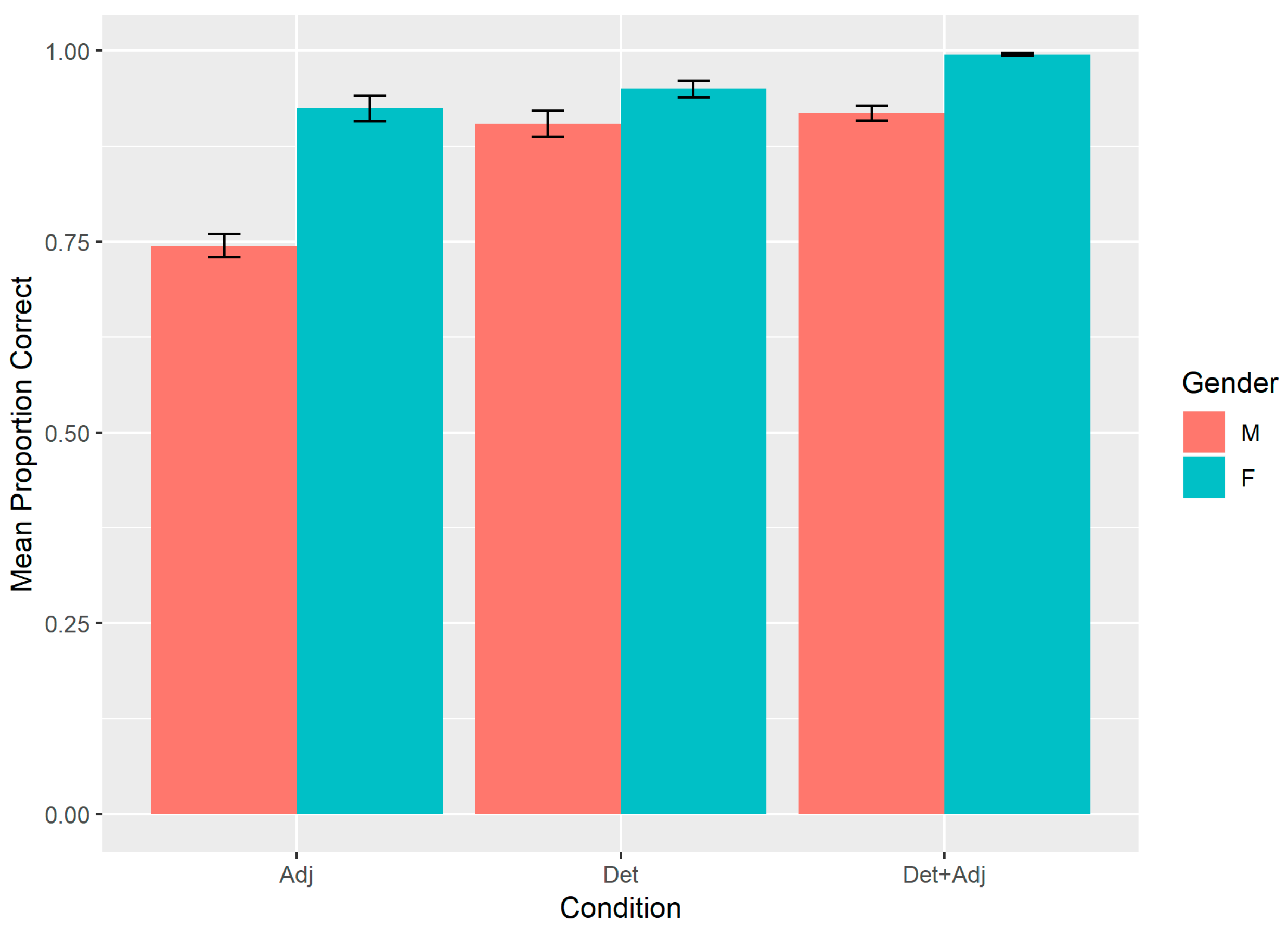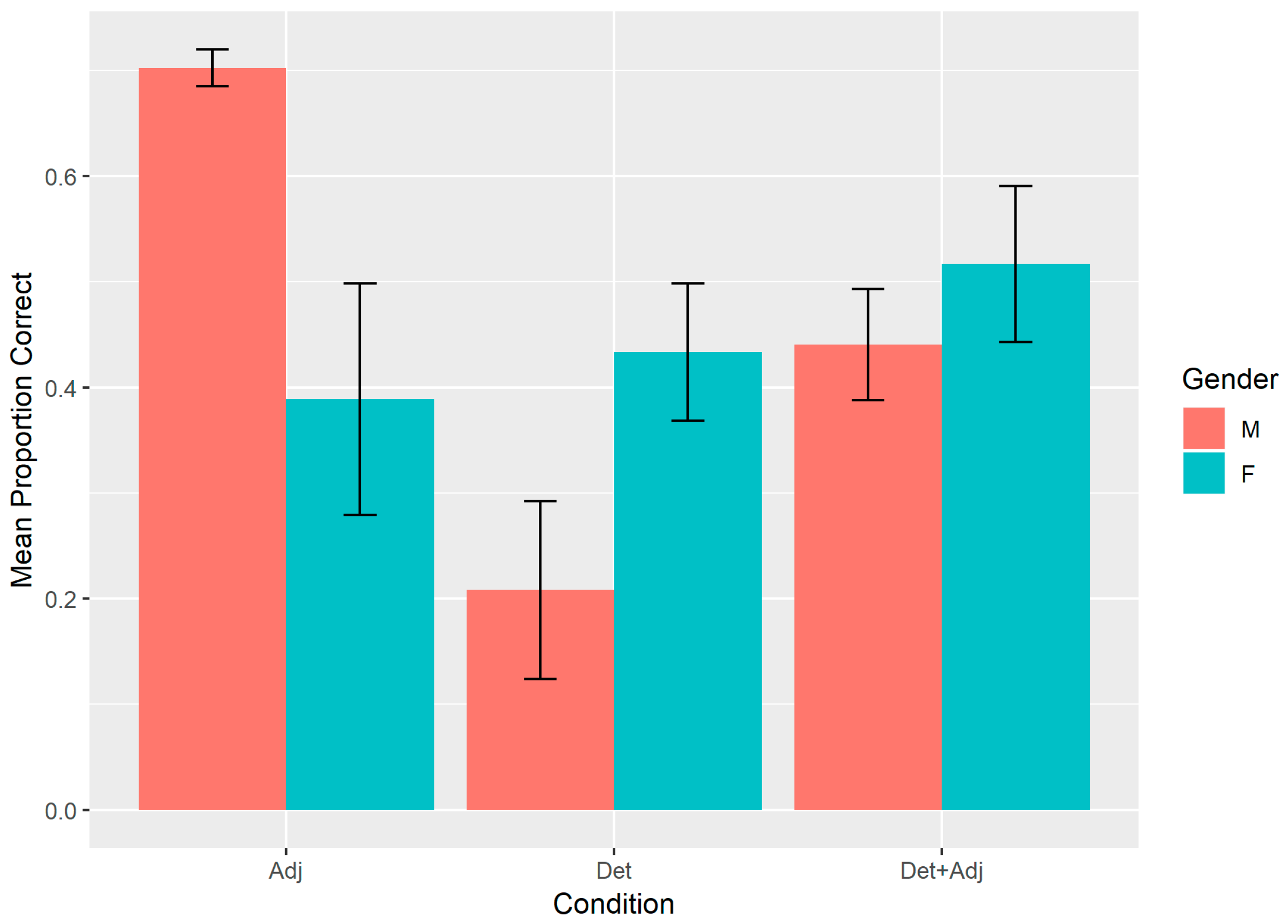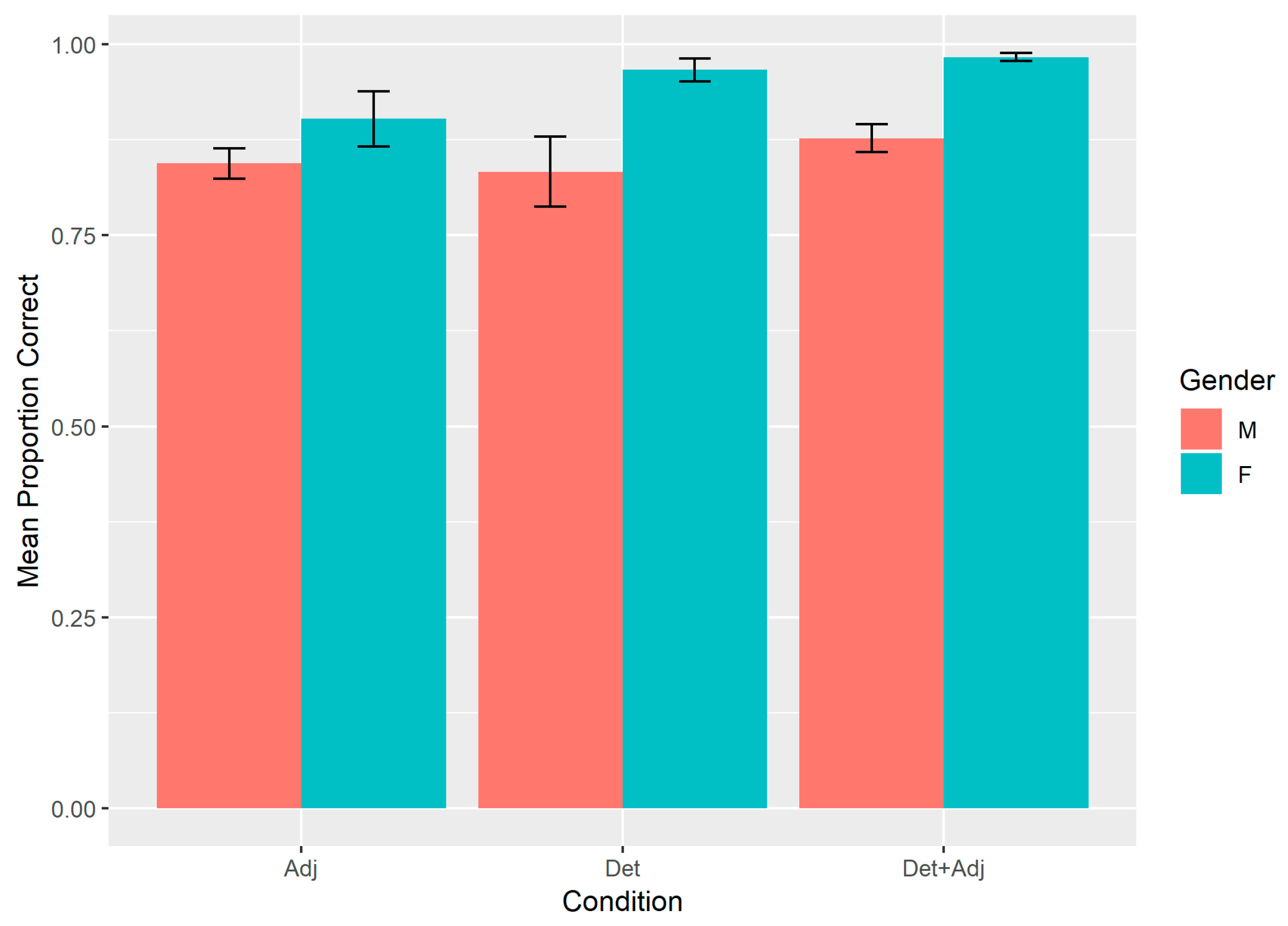Spanish Grammatical Gender Interference in Papiamentu
Abstract
:1. Introduction
1.1. The Nominal Domain in Spanish and Papiamentu
| 1. | a. | Lafem mesafem redondafem |
| b. | EØ mesaØ rondóØ | |
| The table round | ||
| ‘The round table’ | ||
| 2. | a. | Elmasc patomasc blancomasc |
| b. | EØ patuØ blankuØ | |
| The duck white | ||
| ‘The white duck’ |
1.2. Gender Interference in Palenquero-Spanish Speakers
1.3. Current Study: Spanish Grammatical Gender Interference in Papiamentu
2. Materials and Methods
2.1. Participants
| 3. | a. | Dutch Dominant (n = 7) |
| b. | Papiamentu Dominant (n = 22) | |
| c. | Spanish Dominant (n = 6) | |
| d. | Heritage Spanish (HS) Papiamentu (n = 6) |
2.2. Materials
| 5. | a. | Spanish-like feminine gender agreement3: |
| Example stimulus: Lafem pluma blankafem ta suave | ||
| Papiamentu Equivalent: E pluma blanku ta suave | ||
| det feather white TAM soft | ||
| ‘The white feather is soft’ | ||
| b. | Spanish-like masculine gender agreement: | |
| Example stimulus: E paranan chikitomasc ta kanta bunito4 | ||
| Papiamentu Equivalent: E paranan chikitu ta kanta bunita | ||
| det bird-PL small TAM sing beautiful | ||
| ‘The small birds are singing beautifully’ |
2.3. Procedure
3. Results
3.1. Dutch-Dominant Group
3.2. L1 Papiamentu-Dominant Group
3.3. Spanish-Dominant Group
3.4. Heritage Spanish-Papiamentu Group
4. Discussion
Supplementary Materials
Author Contributions
Conflicts of Interest
Appendix A
| Stimuli | Condition | Translation | Gender |
|---|---|---|---|
| Mi amigunan tin un banjo koró 1. | Adj | My friends have a red bathroom. | M |
| E kamisa tin hopi boton koró. | Adj | The shirt has many red buttons. | M |
| E mucha a disidí ku nos mester traha una pisina rondá di e buraku. | Det + Adj | The child decided that we had to make a round swimming pool out of the well. | F |
| El kurason a kuminsá bati masha lihé. | Det | The heart started beating faster. | M |
| El ehérsito semper tabata armó. | Det + Adj | The army was always armed. | M |
| Las islanan ta chikita. | Det + Adj | The islands are small. | F |
| Las bentananan habrí ta bunita. | Det | The open windows are beautiful. | F |
| Las bòternan ta será ku un tapa temporal. | Det | The bottles are closed with a temporary cork. | F |
| Mi primu semper ta bebe biña koró. | Adj | My cousin always drinks red wine. | M |
| Kada djadumingu nos ta bai na misa blanka. | Adj | Every Sunday we go to the white church. | F |
| E stranheronan ta bebe serbesnan bon fria. | Adj | The foreigners are drinking nice cold beers. | F |
| Las palombanan preta ta kome pan. | Det + Adj | The black pigeons are eating bread. | F |
| Einan mester a bende los piskánan. | Det | They sold the fish. | M |
| E mucha hòmber ta bisti un sombré chikito. | Adj | The boy is wearing a small hat. | M |
| Las baiskelnan tin una kadena korá. | Det | The bicycles have a red chain. | F |
| Los brasanan di e señora ta blanko. | Det + Adj | The arms of the woman are white. | M |
| La pluma blanka ta suave. | Det + Adj | The white feather is soft. | M |
| Los kangreunan ta kome e piedra. | Det | The crabs are eating the stone. | M |
| E eksibishon tin una pintura preta. | Det + Adj | The exhibition has a black painting. | F |
| Mi ta stima el aros blanko. | Det + Adj | I love the white rice. | M |
| Los paranan chikito ta kanta bunito. | Det + Adj | The small birds are singing beautifully. | M |
| Mi amigu tin una kara rondá. | Det + Adj | My friend has a round face. | F |
| Los pannan preto no ta dushi. | Det + Adj | The black loaves are not delicious. | M |
| Mi bisiña tin un kabai preto. | Adj | My neighbor has a black horse. | M |
| E hembra ta yuda brui los webunan. | Det | The female helps breading the eggs. | M |
| Den la kaha korá, e hòmber a haña algun potrèt. | Det + Adj | The man found a picture in the red box. | F |
| Una bela blanka a paga durante e seremonia. | Det + Adj | The white candle went out during the ceremony. | F |
| Mi tin un mapa koró di mundu. | Adj | I have a red world map. | M |
| Las uñanan di mi bisiña ta preta. | Det + Adj | The nails of my neighbor are black. | F |
| Mi a kumpra una mesa rondá. | Det + Adj | I bought a round table. | F |
| Los sapatunan tin furu preto. | Det + Adj | The shoes have black lining. | M |
| Nos ta respetá las banderanan komo un símbolo nashonal. | Det | We respect the flags as a national symbol. | F |
| Las kamisanan blanka ta grandi. | Det + Adj | The white shirts are large. | F |
| Kòrsou tin hopi playa turístika | Adj | Curaçao has many touristic beaches. | F |
| Mi ruman tin un kurpa delegó. | Adj | My brother has a skinny body. | M |
| Los avionnan ta chikito. | Det + Adj | The airplanes are small. | M |
| Mi ofisina ta un edifisio koró. | Adj | My office is a red building. | M |
| Ayera mi a kumpra kuminda spañá. | Adj | Yesterday I bought Spanish food. | F |
References
- Abney, Steven Paul. 1987. The English Noun Phrase in Its Sentential Aspect. Ph.D. thesis, MIT, Cambridge, MA, USA. [Google Scholar]
- Bellamy, Kate, M. Carmen Parafita Couto, and Hans Stadthagen-González. 2018. Investigating Gender Assignment Strategies in Mixed Purepecha–Spanish Nominal Constructions. Languages 3: 28. [Google Scholar] [CrossRef]
- Boersma, Paul, and David Weenink. 2012. Praat: Doing Phonetics by Computer [Computer Program]. Version 5.3.16. Available online: http://www.praat.org/ (accessed on 18 September 2019).
- Eddington, David. 2002. Spanish gender assignment in an analogical framework. Journal of Quantitative Linguistics 9: 49–75. [Google Scholar] [CrossRef]
- Grüter, Theres, Casey Lew-Williams, and Anne Fernald. 2012. Grammatical gender in L2: A production or real-time processing problem? Second Language Research 28: 191–215. [Google Scholar] [CrossRef] [PubMed]
- Harris, James W. 1991. The Exponence of Gender in Spanish. Linguistic Inquiry 22: 27–62. [Google Scholar]
- Hopp, Holger. 2013. Grammatical gender in adult L2 acquisition: Relations between lexical and syntactic variability. Second Language Research 29: 33–56. [Google Scholar] [CrossRef]
- Kester, Ellen-Petra. 2011. Language use, language attitudes and identity among Curaçaoan high school students. In Continuity, Divergence and Convergence in Language, Culture and Society on the ABC-Islands. Edited by Nicholas Faraclas, Ronald Severing, Christa Weijer and Elisabeth Echteld. Willemstad: Fundashon di Planifikashon di Idioma, pp. 25–38. [Google Scholar]
- Królikowska, Marta Anna, Emma Bierings, Anne L. Beatty-Martínez, Christian Navarro-Torres, Paola E. Dussias, and M. Carmen Parafita Couto. 2019. Gender-assignment strategies within the bilingual determiner phrase: four Spanish-English communities examined. Paper presented at the 3rd Conference on Bilingualism in the Hispanic and Lusophone World (BHL), Leiden, The Netherlands, January 9–11. [Google Scholar]
- Liceras, Juana M., Raquel Fernández Fuertes, Susana Perales, Rocío Pérez-Tattam, and Kenton Todd Spradlin. 2008. Gender and gender agreement in bilingual native and non-native grammars: A view from child and adult functional-lexical mixings. Lingua 118: 827–51. [Google Scholar] [CrossRef]
- Lipski, John. 2015. From ‘more’ to ‘less’: Spanish, Palenquero (Afro-Colombian creole) and gender agreement. Language, Cognition and Neuroscience 30: 1144–55. [Google Scholar] [CrossRef]
- Lipski, John. 2017. Does gender agreement carry a production cost? Spanish gender vs. Palenquero. In Romance Languages and Linguistic Theory 12: Selected papers from the 45th Linguistic Symposium on Romance Languages (LSRL). Edited by Ruth E.V. Lopes, Juanito Ornelas de Avelar and Sonia M. L. Cyrino. Campinas: John Benjamins Publishing Company, pp. 127–40. [Google Scholar]
- Montrul, Silvina. 2004. The Acquisition of Spanish: Morphosyntactic Development in Monolingual and Bilingual L1 Acquisition. Amsterdam: John Benjamins. [Google Scholar]
- Montrul, Silvina, Rebecca Foote, and Silvia Perpiñán. 2008. Gender agreement in adult second language learners and Spanish heritage speakers: The effects of age and context in acquisition. Language Learning 58: 503–53. [Google Scholar] [CrossRef]
- Munarriz, Amaia, Varun de Castro Arrazola, M. Carmen Parafita Couto, and María José Ezeizabarrena. 2019. Gender in the production of Spanish-Basque mixed nominal constructions. Paper presented at the 3rd Conference on Bilingualism in the Hispanic and Lusophone World (BHL), Leiden, The Netherlands, January 9–11. [Google Scholar]
- Muysken, Pieter. 2013. Language contact outcomes as the result of bilingual optimization strategies. Bilingualism: Language and Cognition 16: 709–30. [Google Scholar] [CrossRef]
- Pablos, Leticia, M. Carmen Parafita Couto, Bastien Boutonnet, Amy de Jong, Marlou Perquin, Annelies de Haan, and Niels O. Schiller. 2019. Adjecitve-noun order in Papiamento-Dutch code-switching. Linguistic Approaches to Bilingualism 9: 710–735. [Google Scholar] [CrossRef]
- Sabourin, Laura, and Laurie A. Stowe. 2008. Second language processing: When are first and second language processed similarly? Second Language Research 24: 397–430. [Google Scholar] [CrossRef]
- Valdés Kroff, Jorge. 2016. Mixed NPs in Spanish–English bilingual speech: Using a corpus-based approach to inform models of sentence processing. In Spanish–English Code-Switching in the Caribbean and the US. Edited by Rosa E. Guzzardo Tamargo, Catherine M. Mazak and M. Carmen Parafita Couto. Amsterdam: John Benjamins, pp. 281–300. [Google Scholar]
| 1 | We refer to our participants as multilinguals because the residents on the island are regularly exposed to Dutch, English, Papiamentu, and Spanish to varying degrees, with the dominant or preferred language often intersecting with racial identity (Kester 2011). For further group characteristics and an extended discussion on Dutch grammatical gender, we refer the reader to the text and Table S1 in the Supplementary Materials. |
| 2 | The original dataset had 40 experimental stimuli, but we subsequently discovered incorrect coding on 2 sentences and removed these from analyses. |
| 3 | For glosses, det = determiner, TAM = tense-aspect-mood particle, and PL = plural. |
| 4 | A reviewer rightly points out that bonito is an adverb derived from an adjective and would not show gender agreement in Spanish. This is the only experimental sentence with such characteristics. For a list of experimental sentences, see Appendix A. |
| 5 | For this experiment, ‘correct’ Papiamentu means that the participants would consider the Papiamentu sentence to be a grammatically well-formed sentence when speaking to another Papiamentu speaker. |




| Adjective Endings | Feminine -a (-o in PAP 1) | Feminine -a (-u in PAP) | Masculine -o (-a in PAP) | Masculine -o (-u in PAP) |
|---|---|---|---|---|
| Example stimulus | rondá | chikita | delegó | blanko |
| Papiamentu | rondó | chikitu | delegá | blanku |
| Spanish equivalent | redondo/a | pequeño/a | delgado/a | blanco/a |
| English translation | ‘round’ | ‘small’ | ‘thin’ | ‘white’ |
| Determiners | Masculine Singular el 1 (e in PAP) | Feminine Singular la/una (e/un in PAP) | Masculine Plural los (e in PAP) | Feminine Plural las (e in PAP) |
|---|---|---|---|---|
| Example stimulus | el aros | una kara | los piskánan | las islanan |
| Papiamentu | e aros | un kara | e piskánan | e islanan |
| Spanish equivalent | el arroz | una cara | los peces/pescados | las islas |
| English translation | ‘the rice’ | ‘a face’ | ‘the fish (plural)’ | ‘the islands’ |
© 2019 by the authors. Licensee MDPI, Basel, Switzerland. This article is an open access article distributed under the terms and conditions of the Creative Commons Attribution (CC BY) license (http://creativecommons.org/licenses/by/4.0/).
Share and Cite
Valdés Kroff, J.R.; Rooijakkers, F.; Parafita Couto, M.C. Spanish Grammatical Gender Interference in Papiamentu. Languages 2019, 4, 78. https://doi.org/10.3390/languages4040078
Valdés Kroff JR, Rooijakkers F, Parafita Couto MC. Spanish Grammatical Gender Interference in Papiamentu. Languages. 2019; 4(4):78. https://doi.org/10.3390/languages4040078
Chicago/Turabian StyleValdés Kroff, Jorge R., Frederieke Rooijakkers, and M. Carmen Parafita Couto. 2019. "Spanish Grammatical Gender Interference in Papiamentu" Languages 4, no. 4: 78. https://doi.org/10.3390/languages4040078
APA StyleValdés Kroff, J. R., Rooijakkers, F., & Parafita Couto, M. C. (2019). Spanish Grammatical Gender Interference in Papiamentu. Languages, 4(4), 78. https://doi.org/10.3390/languages4040078






